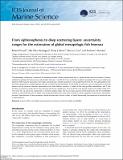Files in this item
From siphonophores to deep scattering layers : uncertainty ranges for the estimation of global mesopelagic fish biomass
Item metadata
| dc.contributor.author | Proud, Roland | |
| dc.contributor.author | Handegard, Nils Olav | |
| dc.contributor.author | Kloser, Rudy | |
| dc.contributor.author | Cox, Martin | |
| dc.contributor.author | Brierley, Andrew Stuart | |
| dc.date.accessioned | 2018-04-20T15:30:11Z | |
| dc.date.available | 2018-04-20T15:30:11Z | |
| dc.date.issued | 2019-05 | |
| dc.identifier | 252882849 | |
| dc.identifier | 103eff96-f760-43b7-bd59-e9cc1cdf4629 | |
| dc.identifier | 85053731631 | |
| dc.identifier | 000484403400010 | |
| dc.identifier.citation | Proud , R , Handegard , N O , Kloser , R , Cox , M & Brierley , A S 2019 , ' From siphonophores to deep scattering layers : uncertainty ranges for the estimation of global mesopelagic fish biomass ' , ICES Journal of Marine Science , vol. 76 , no. 3 , pp. 718-733 . https://doi.org/10.1093/icesjms/fsy037 | en |
| dc.identifier.issn | 1054-3139 | |
| dc.identifier.other | ORCID: /0000-0002-8647-5562/work/43873420 | |
| dc.identifier.other | ORCID: /0000-0002-6438-6892/work/60427347 | |
| dc.identifier.uri | https://hdl.handle.net/10023/13174 | |
| dc.description | Funding: Horizon 2020 Framework Programme, (Grant/Award Number: “692173”). | en |
| dc.description.abstract | The mesopelagic community is important for downward oceanic carbon transportation and is a potential food source for humans. Estimates of global mesopelagic fish biomass vary substantially (between 1 and 20 Gt). Here, we develop a global mesopelagic fish biomass model using daytime 38 kHz acoustic backscatter from deep scattering layers. Model backscatter arises predominantly from fish and siphonophores but the relative proportions of siphonophores and fish, and several of the parameters in the model, are uncertain. We use simulations to estimate biomass and the variance of biomass determined across three different scenarios; S1, where all fish have gas-filled swimbladders, and S2 and S3, where a proportion of fish do not. Our estimates of biomass ranged from 1.8 to 16 Gt (25–75% quartile ranges), and median values of S1 to S3 were 3.8, 4.6, and 8.3 Gt, respectively. A sensitivity analysis shows that for any given quantity of fish backscatter, the fish swimbladder volume, its size distribution and its aspect ratio are the parameters that cause most variation (i.e. lead to greatest uncertainty) in the biomass estimate. Determination of these parameters should be prioritized in future studies, as should determining the proportion of backscatter due to siphonophores. | |
| dc.format.extent | 1230274 | |
| dc.language.iso | eng | |
| dc.relation.ispartof | ICES Journal of Marine Science | en |
| dc.subject | Myctophids | en |
| dc.subject | DSLs | en |
| dc.subject | Acoustics | en |
| dc.subject | Swimbladder | en |
| dc.subject | Pneumatophore | en |
| dc.subject | Scattering models | en |
| dc.subject | Resonance | en |
| dc.subject | GC Oceanography | en |
| dc.subject | QH301 Biology | en |
| dc.subject | NDAS | en |
| dc.subject.lcc | GC | en |
| dc.subject.lcc | QH301 | en |
| dc.title | From siphonophores to deep scattering layers : uncertainty ranges for the estimation of global mesopelagic fish biomass | en |
| dc.type | Journal article | en |
| dc.contributor.sponsor | European Commission | en |
| dc.contributor.institution | University of St Andrews. School of Biology | en |
| dc.contributor.institution | University of St Andrews. Pelagic Ecology Research Group | en |
| dc.contributor.institution | University of St Andrews. Marine Alliance for Science & Technology Scotland | en |
| dc.contributor.institution | University of St Andrews. Scottish Oceans Institute | en |
| dc.contributor.institution | University of St Andrews. Centre for Research into Ecological & Environmental Modelling | en |
| dc.identifier.doi | 10.1093/icesjms/fsy037 | |
| dc.description.status | Peer reviewed | en |
| dc.identifier.grantnumber | 692173 | en |
This item appears in the following Collection(s)
Items in the St Andrews Research Repository are protected by copyright, with all rights reserved, unless otherwise indicated.

